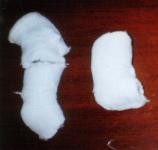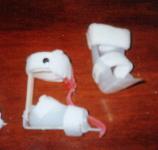|
|
* Initially your baby can be referred to the orthopaedic outpatients at a public hospital specialising in children, where he/she will see a specialist doctor whose expertise includes talipes, or
* Your child can be referred to a private specialist doctor, and you will visit at his/her rooms.
|
 Special Plaster Casting
* The most common initial treatment can start from day one onwards.
Special Plaster Casting
* The most common initial treatment can start from day one onwards.
* The plaster is changed weekly initially, and then 2-weekly, gently moving the foot into the correct position.
|
|
CARE OF CHILD WITH SERIAL PLASTERS
The doctor will apply the plaster from above the knees to the base of the toes.
You may be given a "plaster instruction" sheet which will alert you to any abnormalities. Do not hesitate to contact the doctor or hospital if you are at all concerned with the plaster.
Your doctor or nurse will explain how to remove the plaster in the bath on the morning of your next appointment. Tip: Half a cup of vinegar in the bath water will help dissolve the plaster more quickly.
You may wish to bring your baby's child health record to the hospital and weigh him/her on the scales provided before the plaster is reapplied.
Although the plastering procedure will not cause your baby any pain, he/she may become upset. It appears to help if baby is fed shortly before the plaster is applied, and lots of cuddling afterwards seems to comfort.
There are feeding and changing areas in all hospitals caring for children. Please ask staff for directions to these areas.
It is important not to let the plaster get wet while keeping baby clean. Many parents have found advice in the Australian Breastfeeding Association Booklet "Plastered Kids" invaluable, i'm not sure if it's still available though (2014). While sponging carefully appears to be the safest way, there are some other suggestions, for example, a condom over a small plaster allows your baby to enjoy a normal bath.
It is important to dry carefully around the top of the plaster, as otherwise 'plaster sores' can develop which can be troublesome.
Some parents find cotton wool or skin cream around the skin at the top of the plaster prevents sores from developing.
Conventional cloth nappies can be inadequate on a very small baby in protecting the plaster from soiling. There is a variety of ‘fitted’ cloth nappies with elastic legs on the market, or you may like to use disposable nappies while your child is in plaster.
|
|
Important!
Remember, if you have any questions or concerns during your child's treatment, please ask your child's doctor, who will be happy to provide answers.
Following treatment, children with talipes will go on to lead normal active lives.
They will need to have regular assessment of their feet during childhood and adolescence until they reach maturity, as occasionally there can be a relapse of the condition.
Although their feet will be perfectly functional, some children with one foot affected may require 2 different shoe sizes.
Occasionally the calf muscle will be slightly smaller on the affected side.
http://home.vicnet.net.au/~tips
Surgery
Many children require surgery if it becomes apparent that the foot or feet are not responding to serial plasters or splinting. Surgery is usually performed when the child is about 6 months old, but different children and different doctors mean there is a range in the age of the child undergoing surgery.
Surgery means a day or two in hospital, followed by plaster casting. You will be able to stay with your baby and feed and care for him/her with the staff's guidance. If you are breastfeeding, you will be given support by the nursing staff so that you maintain your supply and be comfortable for the time that your child is fasting.
|
 Ankle Foot Orthosis
Ankle Foot Orthoses (AFO's) Often called a Brace or Splint can be used at various times of your child's treatment, and are often used as a follow-up after serial plasters, or after plasters applied at surgery.
Ankle Foot Orthosis
Ankle Foot Orthoses (AFO's) Often called a Brace or Splint can be used at various times of your child's treatment, and are often used as a follow-up after serial plasters, or after plasters applied at surgery.
Splints are either the denis browne type where the feet and lower leg are splinted, and then attached to a bar which can be adjusted gently daily, until eventually the feet are in the correct position, or
Ankle-foot orthoses (AFO's), which are a light-weight, plastic splint held on by velcro. These can be worn 24 hours a day, or at night only. They can be removed easily for bathing.
|
Severe Cases
Most children won't require surgery, but if they do they usually will only require 1 - 2 surgeries in thier lifetime, but others do require several surgeries over the years.
In some severe cases, the leg also grows 'twisted' and requires major surgery called a 'Distal Tibial Rotational Osteotomy' in which the surgeon has to cut part of the way through the Tibia bone and occasionally through the Fibula as well and straighten the leg and then on screw a steel plate to keep it that way whilst the bones mend in the correct position. The Steel plate is removed at a later date. Physiotherapy is often also required. |
|

